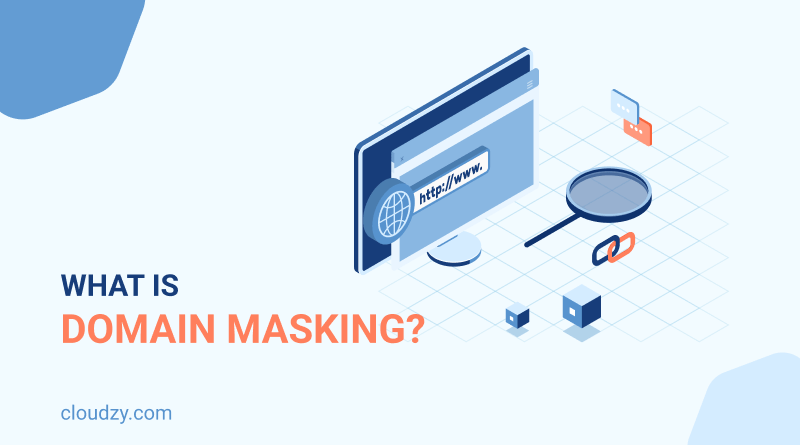In today’s digitally connected world, having a strong online presence has become more crucial than ever. As a result, entrepreneurs, businesses, and individuals alike invest significant time and resources in creating and maintaining a solid web presence. One aspect of this endeavor involves managing the domain name and URL structure of a website.
However, there may be times when you want to conceal your website’s true URL, either to improve branding or for other reasons that we’ll explore later in this blog post. This is where hide URL comes into play. This post will delve into what URL masking is, why you might want to hide a URL, how to implement website masking, and potential downsides and alternatives to consider.
What is Domain Masking?
URL masking is a technique used to display the content of one website under a different domain name or URL. In other words, it’s like sending the website’s visitors to another destination rather than their intended URL. So, when a visitor types in a specific domain name or URL into their browser, they are redirected to a different website but still see the domain name that they entered in the address bar. This is a great way to hide a website’s true URL from users while still providing them with the content they are seeking.
You can redirect a URL in two ways. The first method is when you want to permanently move a website’s content to another URL, but you want to keep the domain name. In this situation, you should do a 301 permanent redirect. The second type is pretty similar to the first one; the only difference is the shorter time period. Imagine your business’s website is broken, and you’re waiting for the web development team to fix the issue. What would happen to the website’s traffic in the meantime? You’re right if you guessed it’s possible to load the same web content with the same URL on another website. For this situation, you should use a 302 temporary redirect.
How Does Hide URL Work?
Hiding URLs is typically achieved by configuring the DNS settings of the domain you want to mask. When users navigate to the masked domain, the DNS settings redirect them to the target website. However, instead of the browser displaying the target website’s URL, it retains the masked URL in the address bar.
To accomplish this, the target website is often displayed within an HTML frame or iframe. The frame essentially acts as a “window” within the browser, displaying the content from the target website while keeping the original URL intact.
Why Would One Want to Hide URLs?
There are several reasons why someone might want to hide their URL using domain forwarding:
Branding and Consistency
Having a consistent brand identity is key to making a lasting impression on your audience. If you have multiple websites or subdomains, using URL masking can help maintain a consistent brand image by ensuring that only your primary domain name is visible in the address bar.
Affiliate Marketing
Affiliate marketers often promote products or services on behalf of other companies. By using domain forwarding, they can hide the affiliate links and create a more professional appearance for their promotions. This can improve trust with potential customers and increase the likelihood of conversions.
Ease of Use and Memorability
If your website has a long, complex, or hard-to-remember URL, hiding the URL can help provide users with a simpler, more memorable alternative. This can make it easier for users to return to your website and share it with others.
Website masking can also be used for URL shortening. By using a different domain name, website owners can create shorter URLs that are easier to share on social media and other platforms.
URL Privacy
In some cases, you might want to keep the actual URL of a website private, either for security reasons or to prevent unauthorized access. Website masking can help achieve this by obscuring the true URL from the public view.
Security
In some cases, website owners may use this method for security reasons. For example, if a website is being targeted by hackers, the owner may choose to use URL hiding to hide the actual URL of the website and make it more difficult for the hackers to find and attack.
How to Implement URL Hiding?
There are several ways to implement URL hiding, depending on your specific needs and technical abilities. Some of the most common methods include:
Using a Domain Registrar
Many domain registrars offer hide URLs as a feature when you purchase a domain name from them. This can be a simple and convenient way to set up URL masking, especially for those with limited technical knowledge. Check with your domain registrar for specific instructions on how to enable website masking.
Using a Web Hosting Service
Some web hosting services also provide hide URLs as part of their hosting packages. If your web host offers this feature, you can usually enable it through your hosting control panel. Consult your web hosting provider’s documentation or support team for assistance in implementing URL hiding.
Using Nginx
The process of implementing a URL hide can also be achieved by using Nginx. Nginx is a popular web server and reverse proxy with a rich package of features that make it a great tool for URL management tasks. You can change Nginx configurations and tell it to show another domain name to users. Here’s an example of an Nginx configuration that helps you achieve URL hide:
server {
listen 80;
server_name alternative-domain.com;
location / {
proxy_pass http://backend-server;
}
}
The example code above tells Nginx as your web server to listen on port 80 and then it defines the alternative domain name that you want to display to users.
URL rewriting
Microsoft offers a module for Windows IIS web server. You can use the Microsoft URL rewrite module to perform all sorts of URL manipulation tasks. Some of these tasks include:
- Changing knotty URLs to simpler ones.
- Replacing current URLs with more user-friendly URLs.
- Rewriting URLs based on the HTTP headers of the website.
URL rewriting works by intercepting requests for a specific URL and redirecting them to a different URL that has been specified by the website owner. This can be done using server-side scripting languages such as PHP, ASP.NET, or Java or through web server configuration files such as .htaccess.
URL rewriting can provide several benefits, including improved search engine optimization, better user experience, and increased security by obscuring the actual URLs of sensitive pages. However, it is important to correctly implement URL rewriting to avoid issues such as broken links, duplicate content, and performance problems.
The Potential Downsides of URL Hiding
While URL masking can be an effective solution for hiding a URL, it also comes with some potential downsides:
SEO Impact
Hiding URLs can have negative effects on search engine optimization (SEO). Since the content displayed within the frame or iframe is hosted on a separate domain, search engines may not be able to properly index and rank your masked website. This can result in lower search engine visibility and reduced organic traffic.
Usability and User Experience
URL hiding can create a confusing user experience. Since the address bar does not update to reflect the actual URL of the target website, users may have difficulty navigating your site or bookmarking specific pages. Additionally, the use of frames or iframes can cause rendering issues on certain devices or browsers, further impacting usability.
Security Concerns
This can raise security concerns, as it can be used to deceive users or hide malicious content. Users may be hesitant to trust a website that employs hide URL, which can negatively affect your online reputation and credibility.
In the table below, we have compared the advantages and disadvantages of the hide url act:
| Hide URL Benefits | Hide URL Risks |
| Protects user privacy | Can be used for phishing scams |
| Helps to maintain brand consistency | Can be used to deceive users |
| Can improve website security | Can negatively impact SEO |
| Allows for easier tracking of website traffic | May confuse users |
| Can reduce the risk of domain squatting | May violate the terms of service for some websites |
What Are the Main Differences Between Domain Masking and Domain Forwarding?
Both of these methods are related concepts, but they refer to different techniques for redirecting website traffic to a different domain. Here are the main differences between the two:
- Displayed URL: With domain masking, the URL displayed in the browser address bar is different from the actual domain of the website. In contrast, with domain forwarding, the actual domain of the website is visible in the browser address bar.
- Website content: With domain masking, the website content is served from the original domain, but the URL is replaced with the masked domain. With domain forwarding, the website content is served from the destination domain.
- Search engine optimization: Domain masking can have a negative impact on search engine optimization (SEO) because search engines may view it as an attempt to manipulate search rankings. In contrast, domain forwarding is generally viewed as a more transparent redirection method and may not have a negative impact on SEO.
- SSL certificates: hide the URL so users may see a security warning if the SSL certificate is not configured properly for the masked domain. With domain forwarding, the SSL certificate is configured for the destination domain, so users will not see any security warnings.
Conclusion
Hide URLs can be an effective way to hide a website’s true URL from users, providing benefits such as improved branding, ease of use, and URL privacy. However, it also comes with potential downsides, including negative SEO impact, usability issues, and security concerns.
Before implementing hide URLs, it’s essential to weigh the benefits against the potential risks and consider alternative solutions, such as Forwarding, 301 redirects, or website rebranding. By carefully evaluating your options, you can choose the best method to manage your online presence and achieve your desired goals.
If you are a small business owner or an individual seeking to establish a website and are in search of a cost-effective web hosting solution, we invite you to reach out to us without hesitation. Our expert support agents are ready to assist you anytime! You may browse through our range of cloud vps products for further information.
Want a high-performance Cloud VPS? Get yours today and only pay for what you use with Cloudzy!![]() Cloud VPS
Cloud VPS
FAQ
Is domain masking the same as domain forwarding?
No, they are two different things. Forwarding involves redirecting a domain name to another domain name, but the actual domain name is displayed in the address bar. With the hide link URL, a different domain name is displayed in the address bar, even though the user is being redirected to a different website.
Can URL masking affect search engine rankings?
Yes, it can have a negative impact on search engine rankings. When a website is masked, search engines may not be able to crawl and index the content on the site, which can result in lower search engine rankings.
Is domain masking legal?
It is not illegal, but it can raise legal issues in some cases. Using a different domain name to mask a website could be considered trademark infringement or other forms of intellectual property theft.
Can url hide be used for phishing attacks?
Yes, it can be used for phishing attacks. When a user visits a website and sees a different URL in the address bar, they may feel like they are being deceived or taken to a phishing site.
Can hiding URLs be used for geo-targeting?
Yes, it can be used for geo-targeting. By using different domain names for different countries or regions, website owners can create a more personalized experience for visitors based on their location.





25 Responses
Oh my goodness! Amazing article dude! Thanks, However I am having issues with your RSS.
I don’t understand the reason why I am unable to
subscribe to it. Is there anybody getting the same RSS issues?
Anyone that knows the answer can you kindly respond? Thanx!!
I constantly spent my half an hour to read this
website’s content daily along with a mug of coffee.
I do trust all of the ideas you’ve offered in your
post. They’re very convincing and will certainly work.
Nonetheless, the posts are very short for beginners.
Could you please lengthen them a little from subsequent time?
Thanks for the post.
Hi, I do think this is an excellent site. I stumbledupon it 😉 I am going to return yet again since i have book-marked it.
Money and freedom is the greatest way to change,
may you be rich and continue to guide others.
Hey there! This is my first visit to your blog! We are a collection of volunteers and starting a new project in a community in the same niche.
Your blog provided us beneficial information to work on. You
have done a marvellous job!
hi!,I love your writing very a lot! proportion we keep in touch extra approximately your post on AOL?
I require a specialist on this space to resolve my problem.
Maybe that’s you! Looking forward to see you.
Simply wish to say your article is as astonishing. The clarity in your post
is simply cool and i could assume you are an expert on this subject.
Fine with your permission let me to grab your RSS feed to keep updated with forthcoming post.
Thanks a million and please continue the gratifying work.
Excellent post but I was wanting to know if you could write a litte more on this subject?
I’d be very thankful if you could elaborate a little bit further.
Kudos!
hey there and thank you for your information – I have
definitely picked up anything new from right here. I did however
expertise some technical points using this site, since I experienced to reload
the website many times previous to I could get it to
load properly. I had been wondering if your web host is OK?
Not that I’m complaining, but slow loading instances times will very frequently affect your placement
in google and could damage your quality score if
advertising and marketing with Adwords. Anyway I’m adding this RSS to my
email and can look out for a lot more of your respective intriguing
content. Make sure you update this again soon.
Thank you very much! We’ll definitely work on improving this.
Greetings! I know this is kinda off topic but I was wondering if you knew where I could get a captcha
plugin for my comment form? I’m using the same blog platform as yours and I’m having difficulty finding one?
Thanks a lot!
Hi! No worries, happy to help. You can find good CAPTCHA plugins like reCAPTCHA by Google or WPForms. Just search for them in the WordPress plugin directory — they’re easy to set up. Good luck!
Hi there, this weekend is pleasant in favor of me, since this point in time
i am reading this great informative piece of writing here at my
home.
Keep this going please, great job!
Oh my goodness! Impressive article dude! Thank you, However I am
having difficulties with your RSS. I don’t understand the reason why I am unable to subscribe to it.
Is there anybody else getting the same RSS issues?
Anyone that knows the answer can you kindly respond?
Thanx!!
Thank you for sharing your opinion. However, I didn’t notice any issue with the site’s RSS. Please check it again.
Wow that was odd. I just wrote an really long comment but after I clicked submit my comment didn’t appear.
Grrrr… well I’m not writing all that over again. Regardless,
just wanted to say superb blog!
Excellent way of telling, and nice article to obtain data on the topic of
my presentation topic, which i am going to deliver in institution of higher education.
Thanks for sharing your thoughts on download
windows 10 full crack 388bet. Regards
You made some decent points there. I looked on the web for additional information about
the issue and found most individuals will go along with your views on this site.
It is appropriate time to make some plans for the future and it’s time
to be happy. I’ve read this post and if I could I desire to suggest you few interesting things or tips.
Perhaps you could write next articles referring to this article.
I desire to read more things about it!
I’d appreciate it if you could leave any suggestions for me in the comments.
how do you say it? Relevant!! Finally I’ve found something which helped me.
Appreciate it!
I think this is one of the most vital info for me.
And i am glad reading your article. But should remark
on some general things, The web site style is wonderful, the articles is really great : D.
Good job, cheers
I do agree with all the concepts you’ve offered for your post.
They’re really convincing and will certainly work. Nonetheless,
the posts are too quick for starters. May you please lengthen them
a little from subsequent time? Thanks for the post.